Experimental Study of Simultaneous Charging and Discharging Process in Thermocline Phase Change Heat Storage System Based on Solar Energy
Abstract
1. Introduction
2. Experimentation
2.1. Experimental System
2.2. Experimental Operating Conditions and Research Parameters
3. Results with Analysis
3.1. The Variation Rules of Charging Power and Solar Radiation Intensity
3.2. The Influence of QV,D on the Average Temperature of Different Heights in the TES Tank
3.3. Evolution of the Thermocline
3.4. Difference in Utilization Rate
4. Conclusions
- (1)
- Theoretically, there is a quantitative relationship between solar radiation intensity and charging power, but it is difficult to express in a relational expression. Their trend of change is similar; the peak of charging power often appears when the solar radiation intensity is close to the maximum. In addition to case 1, from case 2 and case 3, we can see that after the solar radiation intensity is less than 548 W/m2, the decreased rate of charging power is close to the decreased rate of solar radiation intensity.
- (2)
- As an inertial link, the heat storage tank itself can effectively stabilize the fluctuation in solar energy and stabilize the outlet water temperature while participating in heat storage. The average temperatures of the discharging outlet corresponding to case 1, case 2, and case 3 are 76 °C, 73 °C, and 69 °C, respectively. These temperatures are all higher than the phase change temperature of the paraffin. In addition, the time that case 1, case 2, and case 3 can supply the hot water above 69 °C is 1 h 56 min, 3 h 32 min, and 2 h 44 min, respectively. A value is found when the solar radiation intensity is lower than this value (535 W/m2); the temperature at the top of the heat storage tank begins to decrease continuously. Subsequent experiments can fine-tune the discharging flow rate according to this value to further stabilize the discharging outlet temperature.
- (3)
- Considering that the weakening of solar radiation will reduce the temperature of the heat storage inlet and disturb the temperature field in the tank, the simultaneous charging and discharging process should be carried out in the morning. Avoid continuing operating after the utilization rate decreases, which can make the temperature field in the tank more stable and increase the utilization rate.
- (4)
- Increasing the discharging flow rate will increase the whole charging and discharging time, thicken the thermocline, and disturb the temperature field in the tank, but considering the demand of heat release that should be met, there must exist a ‘perfect flow rate’ that can make the discharging efficiency and utilization rate obtain the maximum values, and make the condition of case 2 closer to the ‘perfect flow rate’.
Author Contributions
Funding
Institutional Review Board Statement
Informed Consent Statement
Data Availability Statement
Conflicts of Interest
Nomenclature
| c | specific heat (kJ/(kg·K)) |
| E | energy (kJ) |
| M | mass (kg) |
| Δh | fusion heat (kJ/kg) |
| P | power (kW) |
| QV | volume flow rate (m3/h) |
| T | temperature (°C) |
| t | time (min) |
| λ | thermal conductivity (W/(m·K)) |
| ρ | density (kg/m3) |
| σ | uncertainty |
| η | efficiency |
| Greek symbols | |
| C | charging |
| CW | chilling water |
| D | discharging |
| in | inlet |
| ini | initial |
| l | liquid phase |
| max | maximum |
| min | minimum |
| out | outlet |
| p | paraffin wax |
| pc | phase change |
| s | solid phase |
| ss | stainless steel shell of PCM capsules |
| w | water |
| Subscripts | |
| τ* | dimensionless time |
| Abbreviations | |
| CSP | concentrating solar power |
| HTF | heat transfer fluid |
| PCM | phase change material |
| TES | thermal energy storage |
| UR | utilization rate |
References
- Wu, H. Numerical Simulation and Optimization on Energy Storage Properties of Packed Bed Latent Heat Thermal Energy Storage. Master’s Thesis, North China Electric Power University, Beijing, China, 2019. [Google Scholar]
- Wang, X.H.; He, Z.Y.; Xu, C.; Du, X.Z. Dynamic Simulations on Simultaneous Charging/Discharging Process of Water Thermocline Storage Tank. Proc. CSEE 2019, 39, 5989–5998. [Google Scholar]
- Dufie, J.A.; Beckman, W.A. Solar Energy Thermal Processes; John Wiley & Sons: Hoboken, NJ, USA, 1974. [Google Scholar]
- Lilleleht, L.U.; Beard, J.T.; Lachetta, F.A. Proceedings of the workshop on solar energy storage subsystems for the heating and cooling of buildings. NASASTI/Recon Tech. Rep. N 1975, 76, 30677. [Google Scholar]
- Ismail, K.A.R.; Henriquez, J.R. Numerical and experimental study of spherical capsules packed bed latent heat storage system. Appl. Therm. Eng. 2002, 22, 1705–1716. [Google Scholar] [CrossRef]
- Pacheco, J.E.; Showalter, S.K.; Kolb, W.J. Development of a molten-salt thermocline thermal storage system for parabolic trough plants. J. Sol. Energy Eng. 2002, 124, 153–159. [Google Scholar] [CrossRef]
- Niedermeier, K.; Marocco, L.; Flesch, J.; Mohan, G.; Coventry, J.; Wetzel, T. Performance of molten sodium vs. molten salts in a packed bed thermal energy storage. Appl. Therm. Eng. 2017, 141, 368–377. [Google Scholar] [CrossRef]
- Nallusamy, N.; Sampath, S.; Velraj, R. Experimental Investigation on a Combined Sensible and Latent Heat Storage System Integrated with Constant/Varying (Solar) Heat Sources. Renew. Energy 2007, 32, 1206–1227. [Google Scholar] [CrossRef]
- Fasquelle, T.; Falcoz, Q.; Neveu, P.; Hoffmann, J.F. A temperature threshold evaluation for thermocline energy storage in concentrated solar power plants. Appl. Energy 2018, 212, 1153–1164. [Google Scholar] [CrossRef]
- Bruch, A.; Molina, S.; Esence, T.; Fourmigué, J.F.; Couturier, R. Experimental investigation of cycling behavior of pilot-scale thermal oil packed-bed thermal storage system. Renew. Energy 2017, 103, 277–285. [Google Scholar] [CrossRef]
- Cabeza, L.F.; Ibáñez, M.; Solé, C.; Roca, J.; Nogués, M. Experimentation with a water tank including a PCM module. Sol. Energy Mater. Sol. Cells 2006, 90, 1273–1282. [Google Scholar] [CrossRef]
- He, Z.Y.; Du, X.Z.; Xu, C. Experiments on the combined cycle operation performance of thermocline heat storage with phase change material packed-bed. J. Eng. Thermophys. 2019, 40, 2658–2663. [Google Scholar]
- Zhao, W.; Neti, S.; Oztekin, A. Heat transfer analysis of encapsulated phase change materials. Appl. Therm. Eng. 2013, 50, 143–151. [Google Scholar] [CrossRef]
- Oró, E.; Castell, A.; Chiu, J.; Martin, V.; Cabeza, L.F. Stratification analysis in packed bed thermal energy storage systems. Appl. Energy 2013, 109, 476–487. [Google Scholar] [CrossRef]
- Kumar, G.S.; Nagarajan, D.; Chidambaram, L.A.; Kumaresan, V.; Ding, Y.; Velraj, R. Role of PCM addition on stratification behaviour in a thermal storage tank—An experimental study. Energy 2016, 115, 1168–1178. [Google Scholar] [CrossRef]
- Xu, C.; Wang, Z.F.; He, Y.L.; Li, X.; Bai, F. Sensitivity analysis of the numerical study on the thermal performance of a packed-bed molten salt thermocline thermal storage system. Appl. Energy 2012, 92, 65–75. [Google Scholar] [CrossRef]
- Xu, C.; Wang, Z.F.; He, Y.L.; Li, X.; Bai, F. Parametric study and standby behavior of a packed-bed molten salt thermocline thermal storage system. Renew. Energy 2012, 48, 1–9. [Google Scholar] [CrossRef]
- Wu, S.M.; Fang, G.Y.; Liu, X. Dynamic discharging characteristics simulation on solar heat storage system with spherical capsules using paraffin as heat storage material. Renew. Energy 2011, 36, 1190–1195. [Google Scholar] [CrossRef]
- Zhao, B.C.; Cheng, M.S.; Liu, C.; Dai, Z.M. System-level performance optimization of molten-salt packed-bed thermal energy storage for concentrating solar power. Appl. Energy 2018, 226, 225–239. [Google Scholar] [CrossRef]
- Galione, P.A.; Pérez-Segarra, C.D.; Rodríguez, I.; Lehmkuhl, O.; Rigola, J. A new thermocline-PCM thermal storage concept for CSP plants. Numerical analysis and perspectives. Energy Procedia 2014, 49, 790–799. [Google Scholar] [CrossRef]
- Zhao, B.C.; Cheng, M.S.; Liu, C.; Dai, Z.M. Thermal performance and cost analysis of a multi-layered solid-PCM thermocline thermal energy storage for CSP tower plants. Appl. Energy 2016, 178, 784–799. [Google Scholar] [CrossRef]
- Liao, Z.R.; Zhao, G.K.; Xu, C.; Yang, C.; Jin, Y.; Ju, X.; Du, X. Efficiency analyses of high temperature thermal energy storage systems of rocks only and rock-PCM capsule combination. Sol. Energy 2018, 162, 153–164. [Google Scholar] [CrossRef]
- Elfeky, K.E.; Mohammed, A.G.; Ahmed, N.; Lu, L.; Wang, Q.W. Thermal and economic evaluation of phase change material volume fraction for thermocline tank used in concentrating solar power plants. Appl. Energy 2020, 267, 115054. [Google Scholar] [CrossRef]
- Elfeky, K.E.; Mohammed, A.G.; Wang, Q.W. Cycle cut-off criterion effect on the performance of cascaded, sensible, combined sensible-latent heat storage tank for concentrating solar power plants. Energy 2021, 230, 120771. [Google Scholar] [CrossRef]
- ELSihy, E.S.; Liao, Z.R.; Xu, C.; Du, X.Z. Dynamic characteristics of solid packed-bed thermocline tank using molten-salt as a heat transfer fluid. Int. J. Heat Mass Transf. 2021, 165, 120677. [Google Scholar] [CrossRef]
- ELSihy, E.S.; Xu, C.; Du, X.Z. Cyclic performance of cascaded latent heat thermocline energy storage systems for high-temperature applications. Energy 2022, 239, 122229. [Google Scholar] [CrossRef]
- He, Z.Y. Experimental Study on the Thermocline Storage Tank with Phase Change Material. Master’s Thesis, North China Electric Power University, Beijing, China, 2019. [Google Scholar]
- Mawire, A.; McPherson, M. Experimental characterisation of a thermal energy storage system using temperature and power controlled charging. Renew. Energy 2008, 33, 682–693. [Google Scholar] [CrossRef]
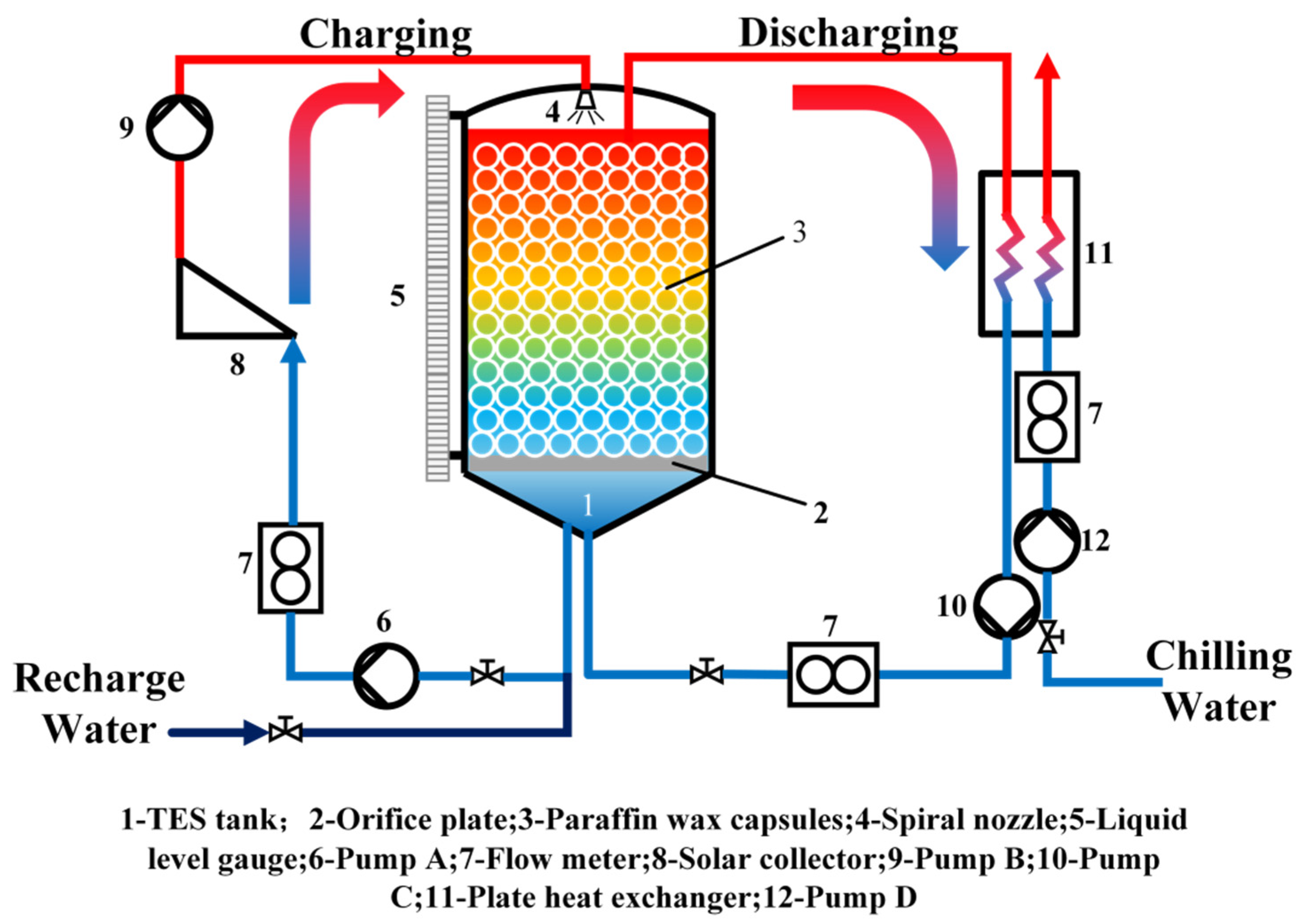
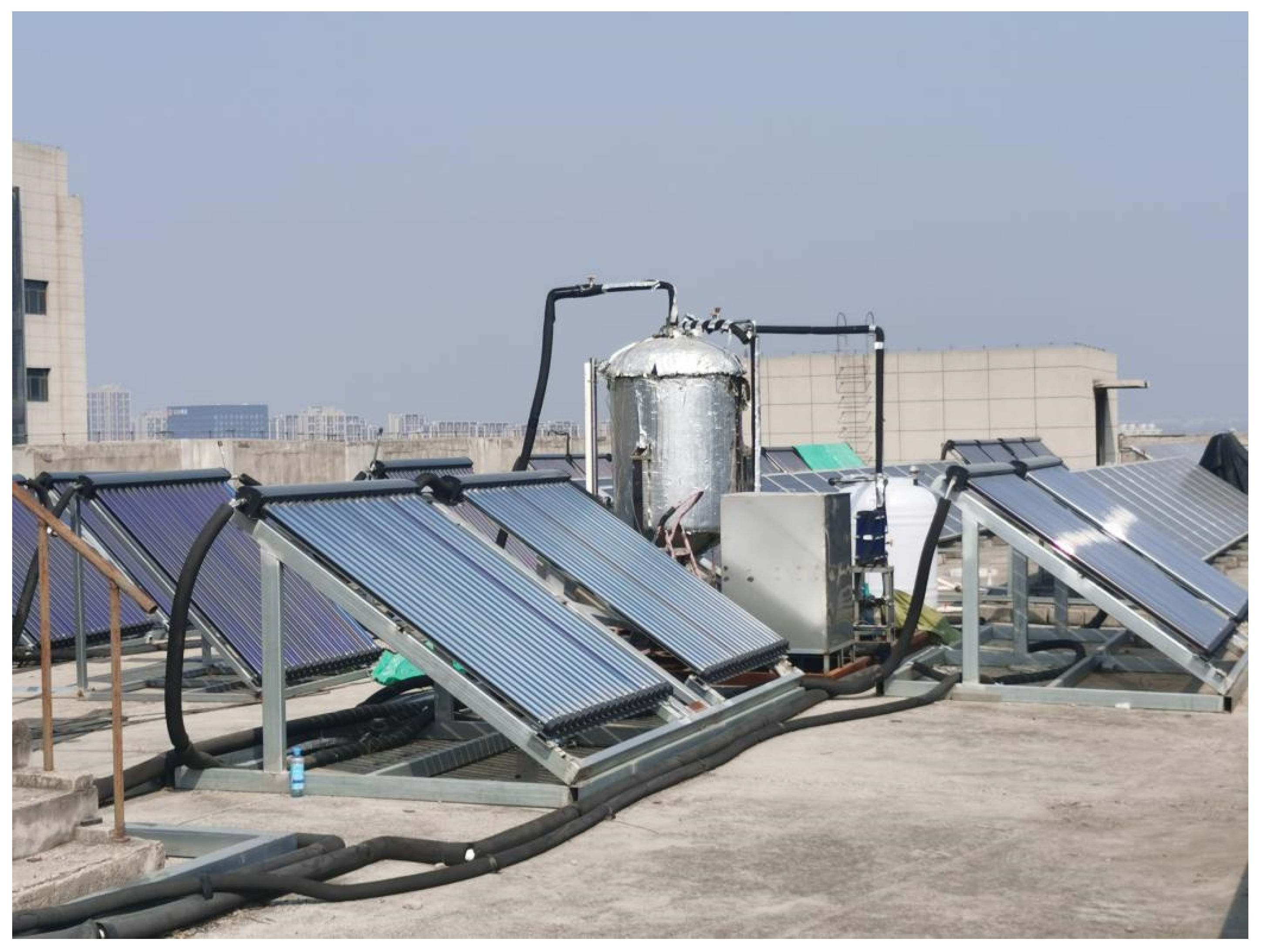
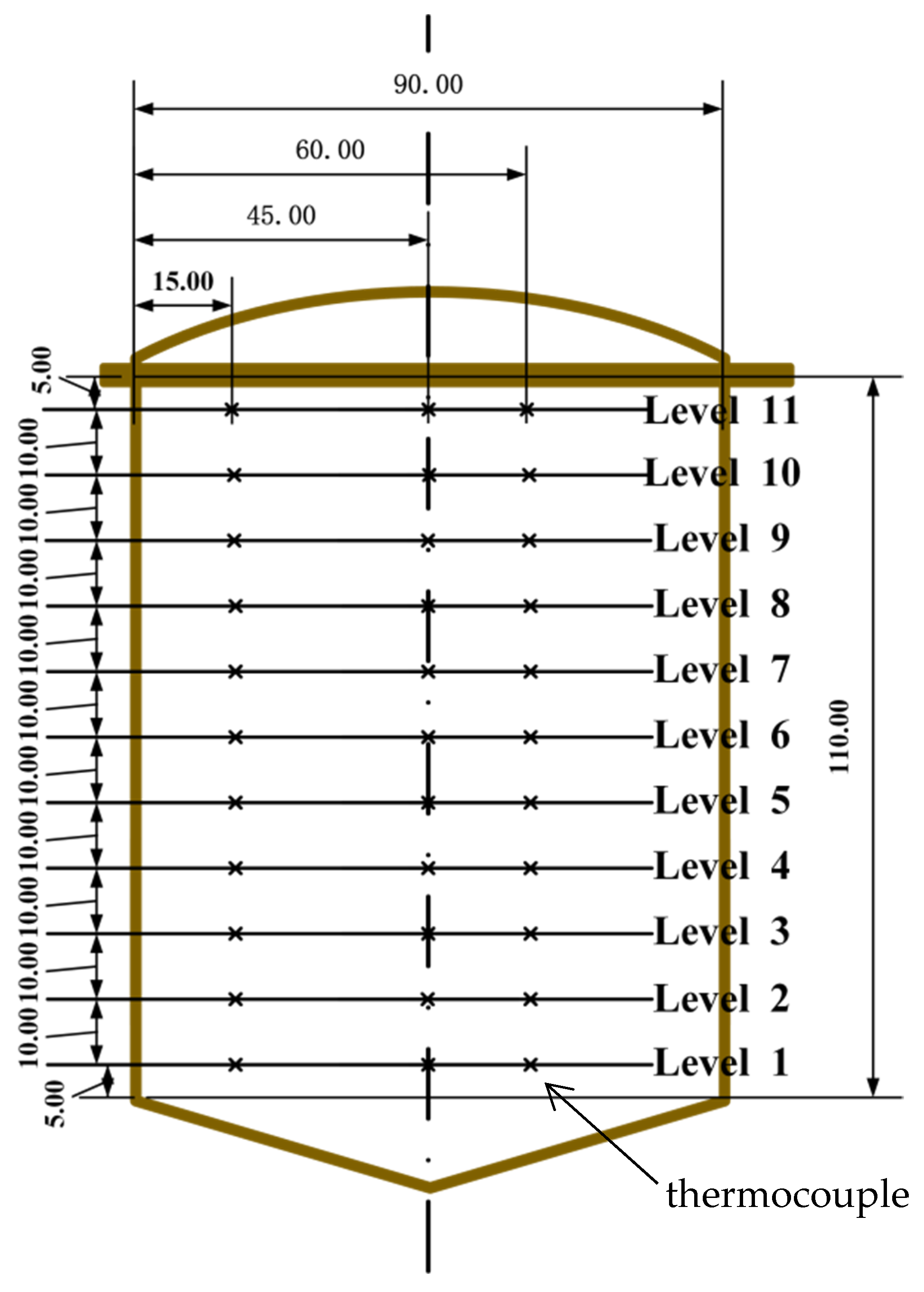
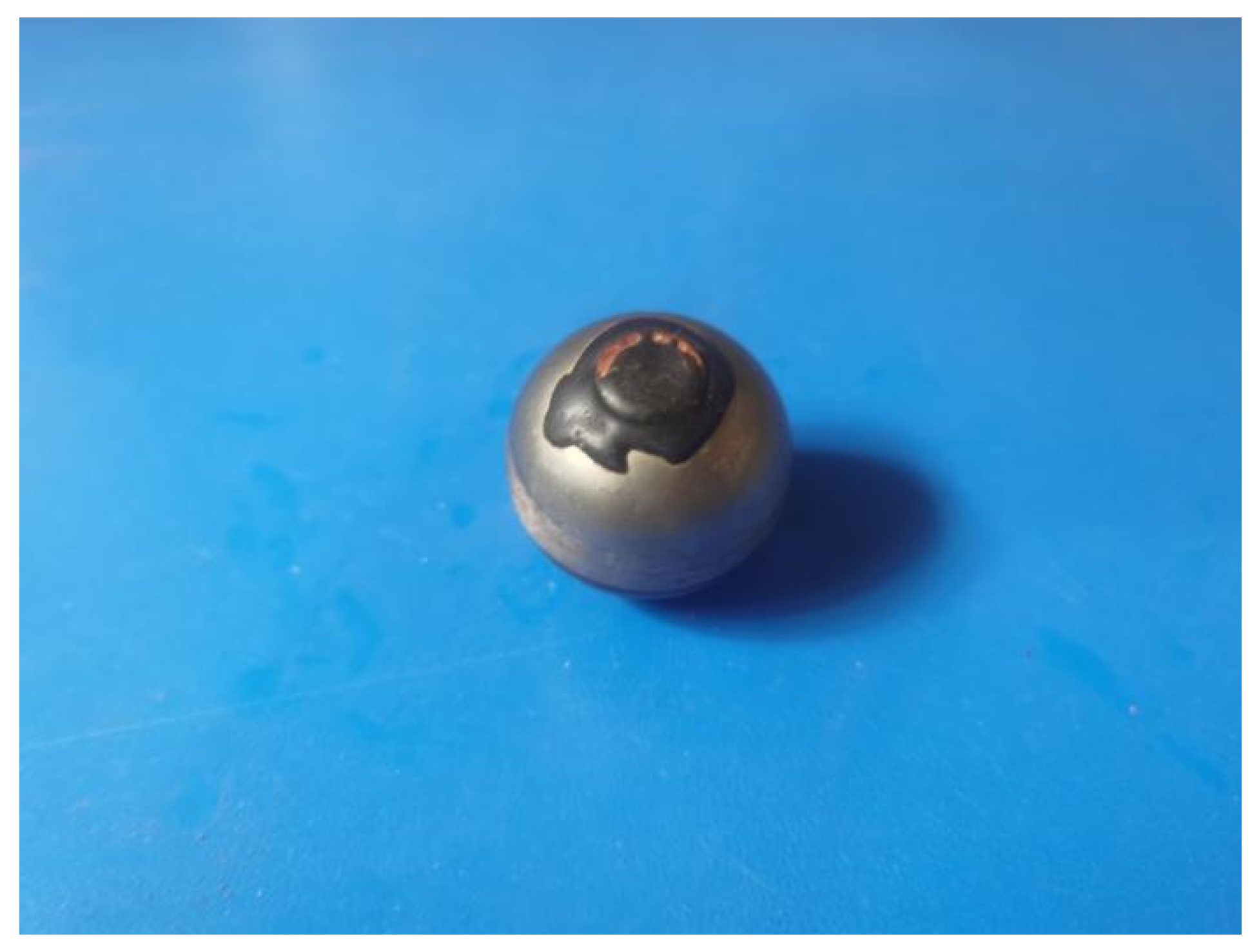
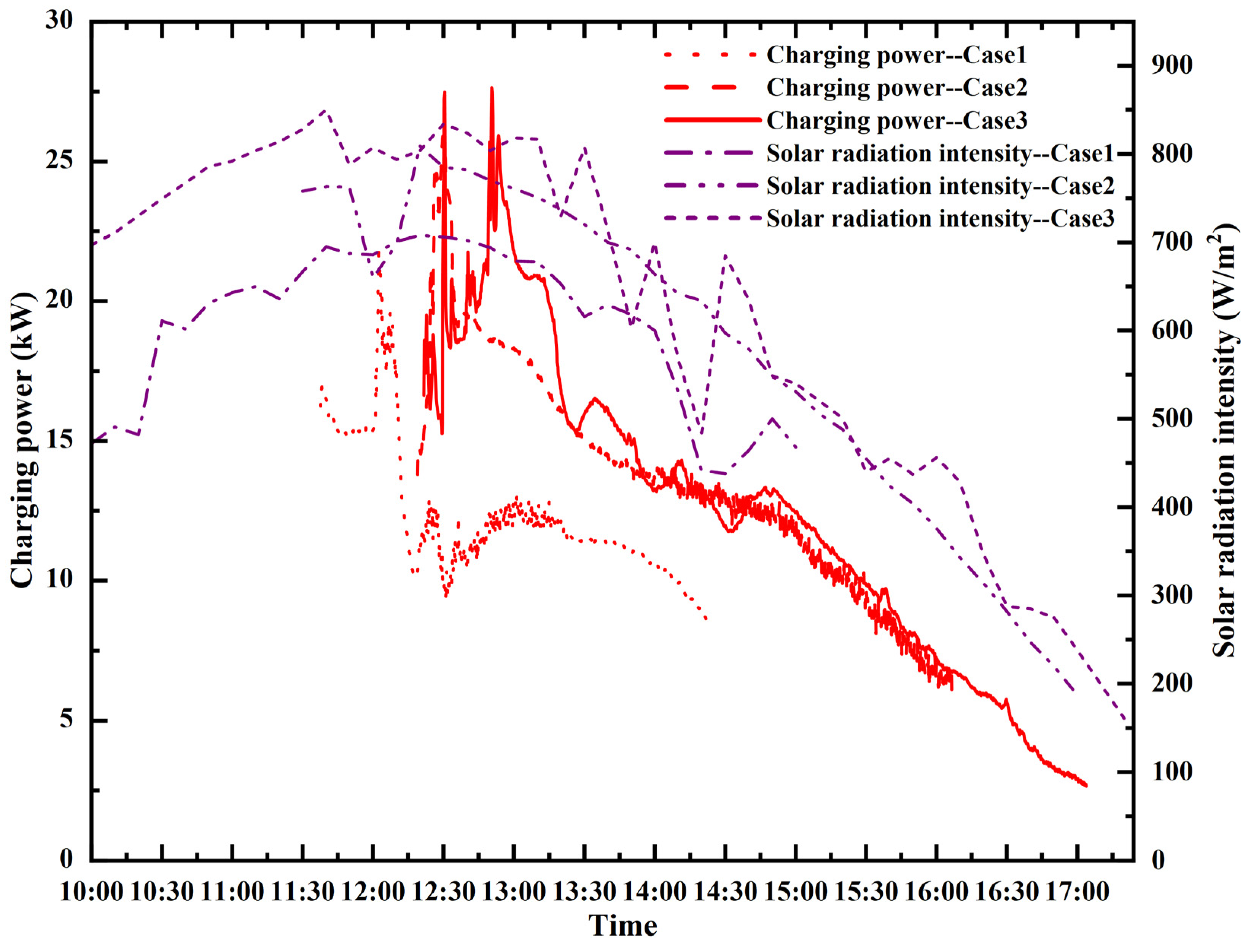
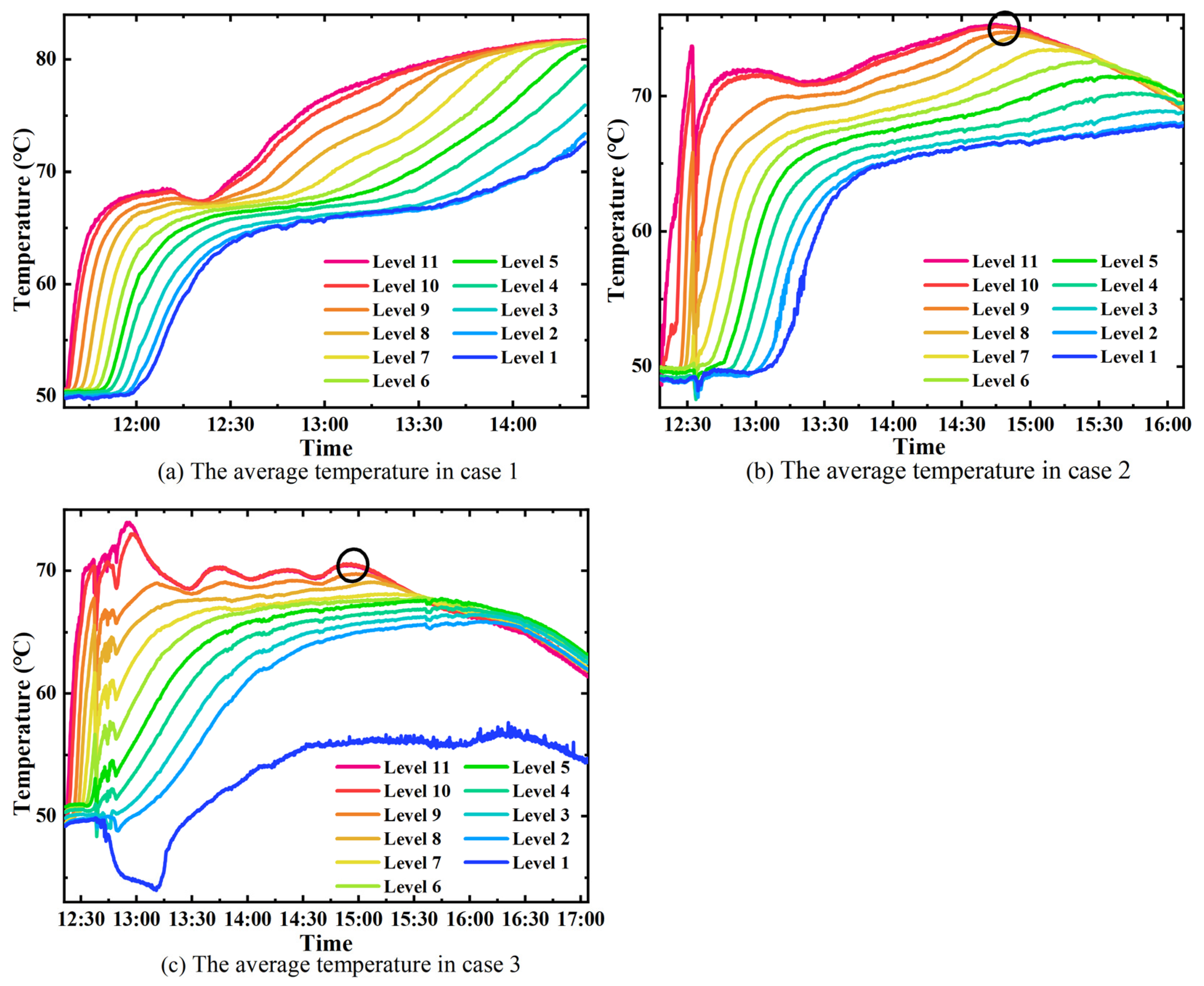
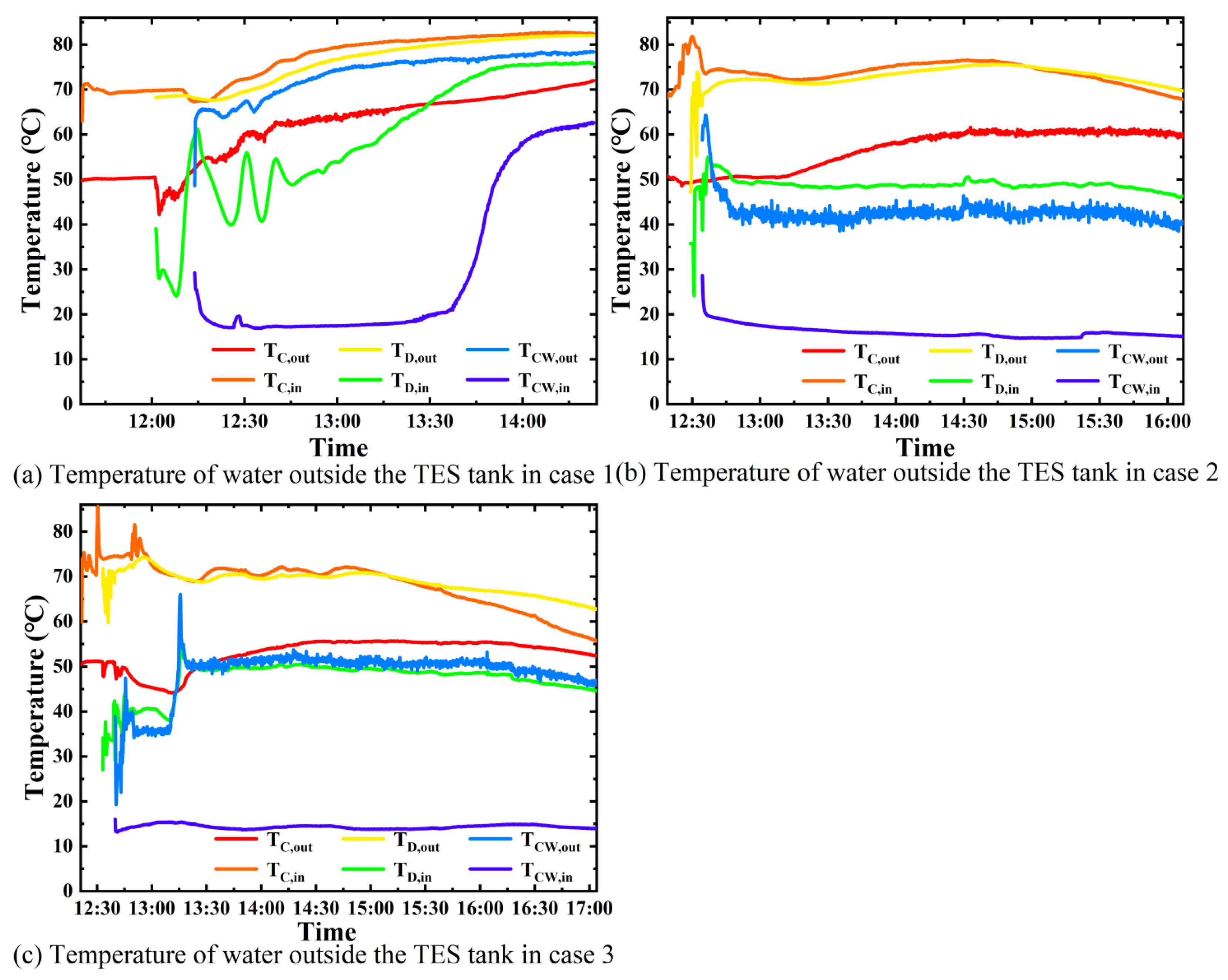
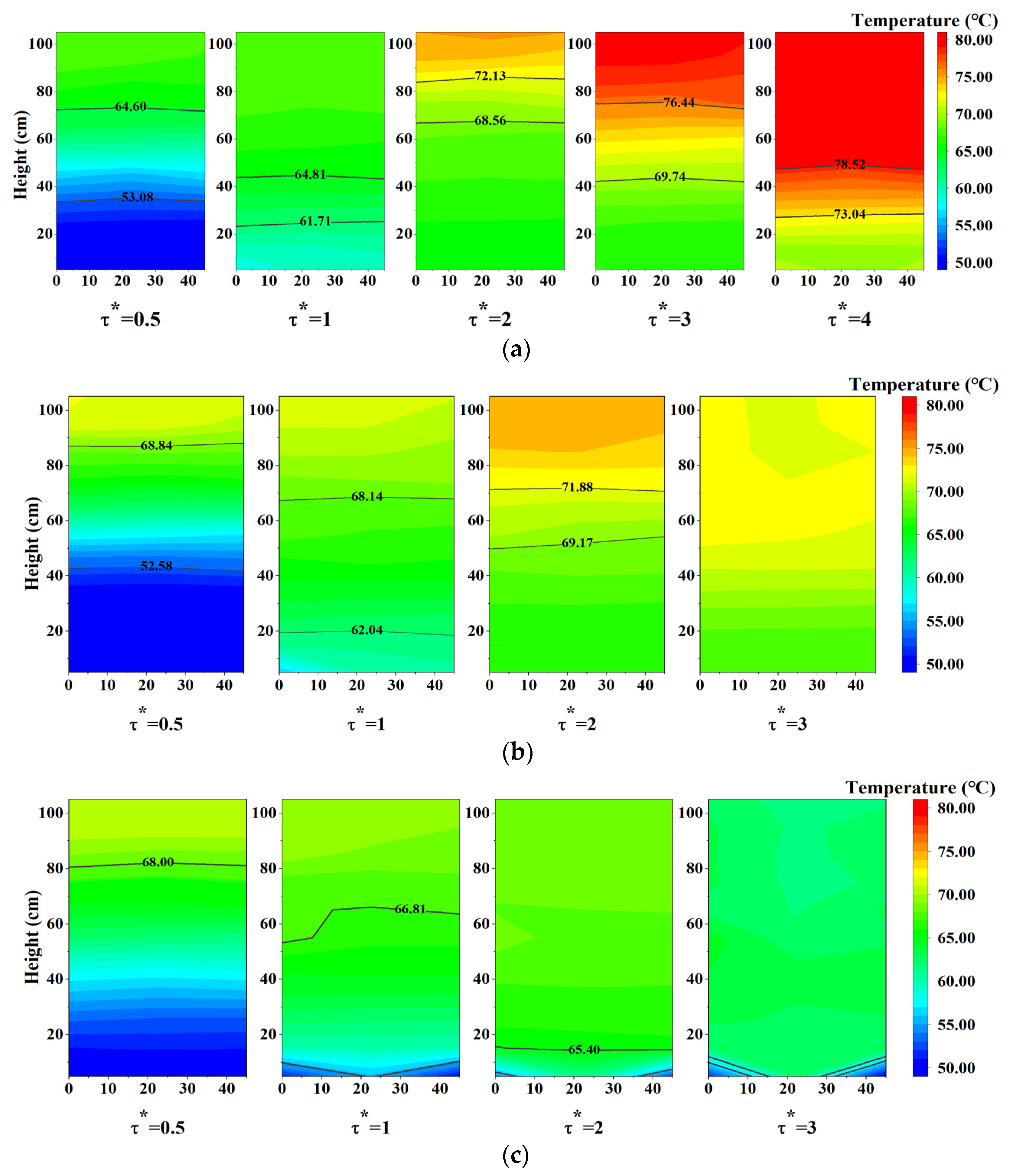
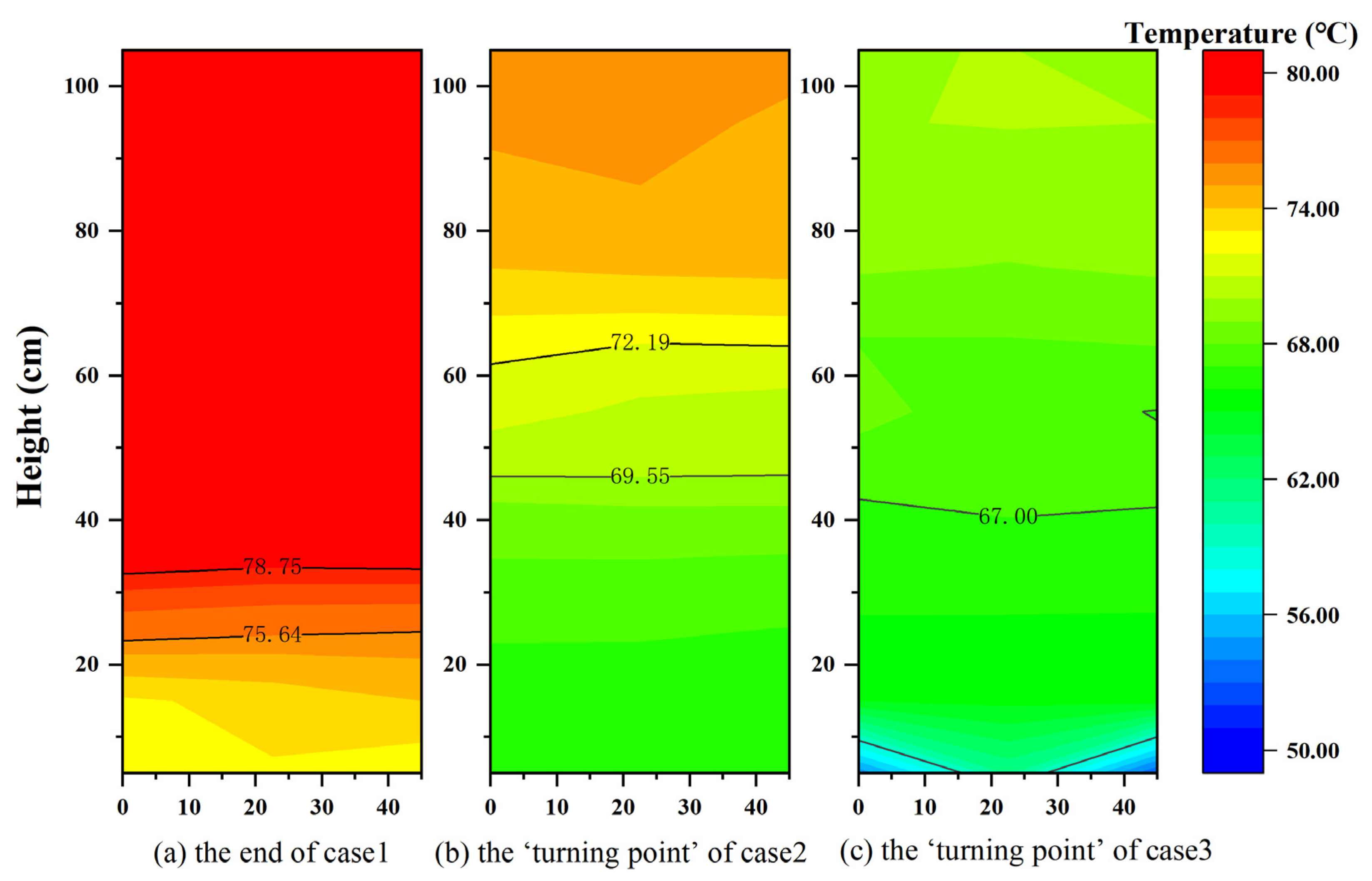
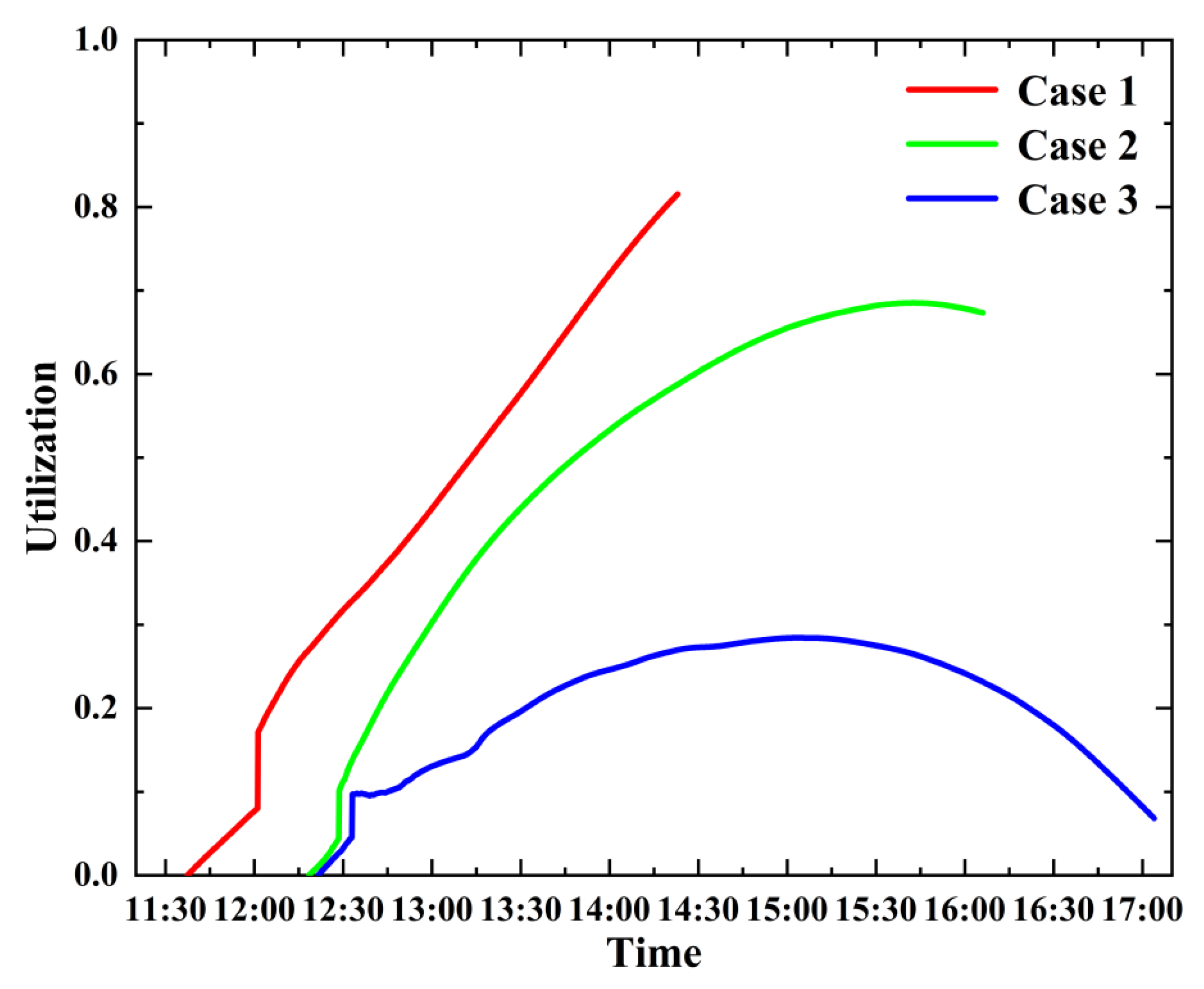
| Paraffin Wax | Value |
| Solid phase density, ρp,s | 838 kg/m3 |
| Liquid phase density, ρp,l | 834 kg/m3 |
| Solid phase specific heat, cp,s | 2.15 kJ/(kg·K) |
| Liquid phase specific heat, cp,l | 2.19 kJ/(kg·K) |
| Solid–liquid phase transition temperature, Tpc | 67–69 °C |
| Solid–liquid phase change latent heat, Δh | 254 kJ/kg |
| Thermal conductivity (solid phase), λp,s | 0.21 W/(m·K) |
| PCM Capsules | Value |
| Density of the shell (at 20 °C), ρss | 7930 kg/m3 |
| Specific heat of the shell (at 20 °C), css | 0.5 kJ/(kg·K) |
| Inner diameter | 41 mm |
| Outer diameter | 42 mm |
| Mass of paraffin wax | 25 g |
| Case | Date | Tini, °C | QV,C, m3/h | QV,D, m3/h | QV,CW, m3/h | TC,in, °C |
|---|---|---|---|---|---|---|
| 1 | 10 April 2022 | 50 | 0.7 | 0.1 | 0.25 | - |
| 2 | 8 April 2022 | 50 | 0.7 | 0.3 | 0.25 | - |
| 3 | 7 April 2022 | 50 | 0.7 | 0.5 | 0.25 | - |
| Parameters | Uncertainty |
|---|---|
| Solar radiation intensity | ±50 W/m2 |
| Volume flow rate, QV | ±0.01 m3/h |
| Temperature, T | ±0.5 °C |
| Charging power, PC | ±0.69 kW |
| Utilization rate, UR | ±0.003 |
| Case | URmax | Time |
|---|---|---|
| 1 | 81.55% | 14:23:01 |
| 2 | 68.52% | 15:42:23 |
| 3 | 28.43% | 15:04:09 |
Disclaimer/Publisher’s Note: The statements, opinions and data contained in all publications are solely those of the individual author(s) and contributor(s) and not of MDPI and/or the editor(s). MDPI and/or the editor(s) disclaim responsibility for any injury to people or property resulting from any ideas, methods, instructions or products referred to in the content. |
© 2023 by the authors. Licensee MDPI, Basel, Switzerland. This article is an open access article distributed under the terms and conditions of the Creative Commons Attribution (CC BY) license (https://creativecommons.org/licenses/by/4.0/).
Share and Cite
Xi, X.; Zhang, Z.; Wei, H.; Chen, Z.; Du, X. Experimental Study of Simultaneous Charging and Discharging Process in Thermocline Phase Change Heat Storage System Based on Solar Energy. Sustainability 2023, 15, 7322. https://doi.org/10.3390/su15097322
Xi X, Zhang Z, Wei H, Chen Z, Du X. Experimental Study of Simultaneous Charging and Discharging Process in Thermocline Phase Change Heat Storage System Based on Solar Energy. Sustainability. 2023; 15(9):7322. https://doi.org/10.3390/su15097322
Chicago/Turabian StyleXi, Xinming, Zicheng Zhang, Huimin Wei, Zeyu Chen, and Xiaoze Du. 2023. "Experimental Study of Simultaneous Charging and Discharging Process in Thermocline Phase Change Heat Storage System Based on Solar Energy" Sustainability 15, no. 9: 7322. https://doi.org/10.3390/su15097322
APA StyleXi, X., Zhang, Z., Wei, H., Chen, Z., & Du, X. (2023). Experimental Study of Simultaneous Charging and Discharging Process in Thermocline Phase Change Heat Storage System Based on Solar Energy. Sustainability, 15(9), 7322. https://doi.org/10.3390/su15097322









